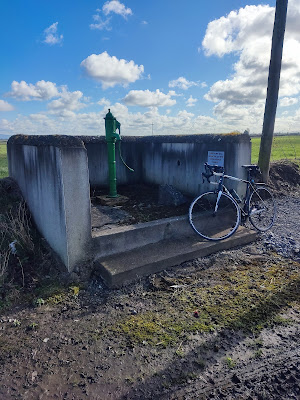The towland of Nicholastown lies roughly 1 kilometre South east of Kilcullen in county Kildare along the R413 road to Brannockstown.
The Effigial Tomb of Roland FitzEustace, Baron Portlester and described as Lord Chancellor and his wife, Margaret D'Artois (nee Jenico) is located at a small graveyard at New Abbey in Nicholastown.
Roland had also held the titles of Lord Treasurer and Lord Deputy.
Roland is buried here in the grounds of the Franciscan Church which they established in 1486.
A Church is also mentioned earlier here on the site circa 1460.
Margaret is mentioned by one particular source as buried in Saint Audoen's Church near Christchurch in Dublin however the SMR for Saint Audoen's records her as being buried at New Abbey along with Roland.
Another source records her place of death as Saint Audoen's Church in Dublin but her place of burial as New Abbey. This is the most likely explanation for any confusion.
The FitzEustace family are associated with nearby Baltinglass and Ballymore Eustace in west Wicklow and Naas in Kildare.
The date given for the death of Roland FitzEustace is ten years after the establishment of the Church at New Abbey under FitzEustace auspices, 1496.
Roland and Margaret are also associated with Saint Audoen's Church in Dublin where he had a Chapel built and in which there is another effigial monument in memory of Roland and his wife, Margaret.
This tomb like monument is described as a Cenotaph which is a monument to someone buried elsewhere.
The side panels from the tomb at New Abbey are incorporated into what little remains of the Church walls.
The top of the tomb has been removed and is partially covered in a thoughtfully designed enclosure and standing upright which helps protect it from the damaging effects of weathering.
It depicts Roland in full Knight regalia dressed in medieval armour and helmet. To the side his wife Margaret is wearing a long Dress and a type of twin horned bonnet known as an Escoffion. Both have pillows under their heads.
During the mid 1450's Roland was appointed Deputy to the Duke of York however it appears that at a later date he was tried but acquitted of plotting against the Crown.
Located within the graveyard are gravestones, tombs and monuments dating from the 1400's and subsequent centuries until later contemporary years.
There are two fonts built into parts of the walls at New Abbey. One is circular in shape, the other rectangular.
While I didn't look closely at the time they appear to be carved of granite. I have found no information which dates the fonts although they are possibly remnants from the medieval 1400's Church.
By all accounts it appears the Franciscan Church was a sizeable structure, a Nave and Chancel Church with belfry and transepts and several acres of harvest gardens.
There is some stonework from the Original Church dotted about the graveyard.
I enjoyed visiting and viewing the effigies of Roland and his wife both at Saint Audoen's in Dublin where the effigy had the faithful dog at his Master's feet and here in Nicholastown in Kildare.
The graveyard at New Abbey has enough points of interest and small antiquities dotted about to recommend visiting if you are ever in the area.
Keep the wheels turning.
Library Ireland - Sir Roland FitzEustace
Eustace Families Association - In Government
Humphry Genealogy - Roland FitzEustace
Margaret Maud d'Artois - Family Search
Wikitree - Margaret FitzEustace
Coordinates here :
53°07'39.3"N
6°44'07.5"W
53.127572 -6.735427
.jpg)
.jpg)
.jpg)
.jpg)
.jpg)
.jpg)
.jpg)
.jpg)
.jpg)
.jpg)
.jpg)
.jpg)
.jpg)
.jpg)
.jpg)
.jpg)
.jpg)
.jpg)
.jpg)
.jpg)
.jpg)
.jpg)
.jpg)
.jpg)
.jpg)
.jpg)
.jpg)
.jpg)
.jpg)
.jpg)
.jpg)
.jpg)
.jpg)
.jpg)
.jpg)
.jpg)
.jpg)
.jpg)
.jpg)
.jpg)
.jpg)
.jpg)
.jpg)
.jpg)

.jpg)
.jpg)
.jpg)
.jpg)
.jpg)
.jpg)
.jpg)
.jpg)
.jpg)
.jpg)
.jpg)
.jpg)
.jpg)
.jpg)
.jpg)